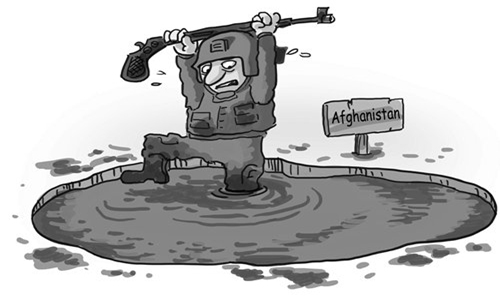HOME >> OPINION
The US wants to get out of Afghanistan so it can deal with China
By Zhu Feng Source:Global Times Published: 2020/3/8 22:18:40

Illustration: Liu Rui/GT
The US launched an airstrike against the Taliban in Afghanistan on Wednesday, days after the Donald Trump administration signed a peace deal with the military group. Although the US-Taliban conditional peace agreement marks the beginning of a substantial withdrawal of US troops from Afghanistan and the potential for ending 18 years of war, uncertainties remain in the war-torn region.
The agreement demonstrates the unprecedented political determination of the Trump administration to leave Afghanistan. The agreement signed by the Trump administration has acknowledged the legitimacy of the Taliban forces and its willingness to accept the possibility that the Taliban may regain power after the withdrawal of foreign troops.
Why is Washington so determined to withdraw from Afghanistan? There is one main reason: The American public has lost all interest in continuing the war in Afghanistan. There is also this factor to be taken into consideration: The current focus of the US strategy is to fully disengage from counter-terrorism operations so the country can concentrate on confronting China - which it has labeled a strategic competitor.
Both the 2017 National Security Strategy Report and the 2018 National Defense Strategy of the US have clearly expressed a substantive shift in the country's strategic focus.
On March 1, US Secretary of Defense Mark Esper couldn't wait to publicly state that the peace agreement with the Taliban was designed to "reallocate forces" so that higher priority can be given to strategic competition with China.
The US announced its Indo-Pacific Strategy in November 2017, which coincided with the start of talks between Washington and the Taliban. What Washington wants is not only to get rid of the Afghanistan burden, but also to stop spending huge sum in Afghanistan, and use the savings to better deploy its forces in the Asia-pacific region in order to contain China. The Pentagon has stated many times that the US is considering how it can expand its military presence in the Indo-Pacific region.
Afghanistan has been a nightmare for two great powers. The Soviet Union invaded Afghanistan in 1979 and failed. The US has spent some $800 billion on its war in the country which has cost the lives of about 3,000 US troops.
The Afghan government, led by President Ashraf Ghani, is very unhappy with the US-Taliban peace deal and has refused to release 5,000 Taliban prisoners as required by the deal. There is little chance of a true power-sharing arrangement between the Taliban and the existing government in Kabul once the Americans leave. After 18 years of war in Afghanistan, with most of the country economically devastated and numerous religious and political factions, the return of the Taliban is likely to mean extremist Muslims rise again to power and a return to violence.
Added to this mix, there is dispute between India and Pakistan as both of them attempt to expand their influence in Afghanistan. With the Taliban still getting strong support in Pakistan, Afghanistan could even become a new epicenter of regional unrest in South Asia.
Once extremist Muslims return to power in Afghanistan, this could also bring potential instability to China's Xinjiang Uygur Autonomous Region. This serves the US strategy of great power competition. The US is now eager to get out of Afghanistan even if it means disregarding the very real potential that Afghanistan will be swamped by extremist violence. Allowing extremist Muslim forces to move eastward could also very well be an intended consequence of the US deal with the Taliban. The US-Taliban deal has done little to clear the muddy waters of the Afghan war.
The author is the executive director of the China Center for Collaborative Studies of the South China Sea at Nanjing University. opinion@globaltimes.com.cn
Posted in: VIEWPOINT